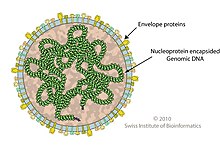Globuloviridae
| Globuloviridae | |
|---|---|

| |
| Virus classification | |
| (unranked): | Virus |
| Realm: | incertae sedis |
| Kingdom: | incertae sedis |
| Phylum: | incertae sedis |
| Class: | incertae sedis |
| Order: | incertae sedis |
| Family: | Globuloviridae |
| Genera | |
| |

Negative-contrast electron micrographs of virions of Pyrobaculum spherical virus (PSV, genus Alphaglobulovirus). (Left) Intact virions; arrows indicate spherical protrusions. (Right) Partially disrupted virions extruding disordered nucleoprotein core. The bars represent 100 nm. Modified from (Häring et al., 2004; provided by ICTV).
Globuloviridae is a family of hyperthermophilic archaeal viruses. Crenarchaea of the genera Pyrobaculum and Thermoproteus serve as natural hosts. There are four species in this family, assigned to a single genus, Alphaglobulovirus.[1][2][3]
Taxonomy[]
The family contains one genus which contains four species:[3]
- Alphaglobulovirus
Structure[]
Virions in the Globuloviridae are spherical and enveloped. The diameter is around 100 nm.[1][2]

Genome organization of Pyrobaculum spherical virus (PSV) showing location, sizes and direction of putative genes.
Genomes are linear dsDNA and non-segmented, around 20-30kb in length.[1][2]
| Genus | Structure | Symmetry | Capsid | Genomic arrangement | Genomic segmentation |
|---|---|---|---|---|---|
| Alphaglobulovirus | Spherical | Enveloped | Linear | Monopartite |
Life cycle[]
Viral replication is cytoplasmic. DNA-templated transcription is the method of transcription. Pyrobaculum and Thermoproteus archaea serve as the natural host. Transmission routes are passive diffusion.[1]
| Genus | Host details | Tissue tropism | Entry details | Release details | Replication site | Assembly site | Transmission |
|---|---|---|---|---|---|---|---|
| Alphaglobulovirus | Pyrobaculum and Thermoproteus archaea | None | Injection | Budding | Cytoplasm | Cytoplasm | Passive diffusion |
References[]
- ^ a b c d Prangishvili, D; Krupovic, M; ICTV Report Consortium (2018). "ICTV Virus Taxonomy Profile: Globuloviridae". The Journal of General Virology. 99 (10): 1357–1358. doi:10.1099/jgv.0.001123. PMID 30091697.
- ^ a b c "Viral Zone". ExPASy. Retrieved 15 June 2015.
- ^ a b "Virus Taxonomy: 2020 Release". International Committee on Taxonomy of Viruses (ICTV). March 2021. Retrieved 24 May 2021.
- Häring M, Peng X, Brügger K, Rachel R, Stetter KO, Garrett RA, Prangishvili D (2004). "Morphology and genome organization of the virus PSV of the hyperthermophilic archaeal genera Pyrobaculum and Thermoproteus: a novel virus family, the Globuloviridae". Virology. 323 (2): 233–242. doi:10.1016/j.virol.2004.03.002. PMID 15193919.
External links[]
Categories:
- Globuloviridae
- Archaeal viruses
- Virus families